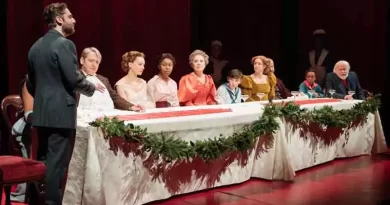“Cow | Deer” at Royal Court Jerwood Theatre Upstairs
Jeremy Malies in West London
15 September 2025
★★
A Foley artist makes the sound of a cow’s amniotic sac dropping from her hind quarters and I don’t recognize it. Silly me, but I may be the bluntest tool in the room.
Working with Nina Segal and Melanie Wilson as her co-creators, Katie Mitchell has collaborated with four Foley artists (two are also accomplished stage actors) in an auditory representation of adjacent fields in England on a summer’s day. Our hearing points are the worlds perceived by the cow and a roe deer.
Many of the sounds are created in front of us by the performers who stand at desks made of hay bales. The objects that produce the sounds include a jar of hand cream, a hot water bottle, airline luggage scales, some pak choi (it produced knowledgeable titters) and my favourite – a can of dried cannellini beans. This list is selective and sly of course; there were dozens of things including the obligatory coconut shell halves.
The evening never recovered for me as I began by reading what I contend are platitudinous (and patronizing) programme notes. “Why is the climate emergency largely absent from contemporary theatre? Is it through lack of awareness? Necessary denial? Fear?”
Where has the creative team been to make glib misguided criticism like this? From Astrov’s obsession with deforestation in Uncle Vanya to Hadestown through Kyoto, Arctic Oil (Clare Duffy), Earthquakes in London (Mike Bartlett), and several plays by Caryl Churchill, you can compile a slew of climate drama. The writers concerned are hardly outlier eccentrics. I once spent a whole Edinburgh Festival Fringe covering climate plays only.
The Foley score has been originated by Tom Espiner and Ruth Sullivan who perform alongside Pandora Colin and Tatenda Matsavi. What irritated me about the project is that in addition to the sounds produced live for us there is a whole set of pre-prepared sounds (“the field recording”) featuring birds, vehicles, and even a farmer speaking or at least muttering.
This struck me as like playing tennis with the net down. I’m aware that “Foley” is now used loosely in drama as shorthand for sound elements outside the usual scope. But I can’t get over my view of Foley as addition or emphasis of sounds in which the artist works with what has already been filmed. I recall a treatment of this on stage in Berberian Sound Studio at Donmar Warehouse in 2019 which also featured Espiner.
We are encouraged to absorb all we can and close our eyes if we wish. But watching a man beating a piece of leather with a damp towel proved compelling in an odd way though not necessarily entertaining. A card handed to us tells us not to fret – we won’t grasp everything because we’re human. (Yuk!) The notes also make mention of “feminist listening” which galled me.
I wanted to understand what was going on and paid close attention. Minor triumphs early in the hour included working out which animal was which as a little whip swished away flies from the cow. But my irritation rose as I felt that I was doing a particularly tough exam with only modest gains from my concentration levels. And as somebody who grew up around roe deer in the Ashdown Forest, I felt no kinship as the deer meets a guessed-at fate.
I agree with the creative team’s assertion that “listening to the world is a process of stilling oneself, of tuning in to what exists”. When I allowed the sounds to wash over me, I was at peace and the experience approached ASMR. And insofar as the project has prompted me to use my ears more it might make me a more attentive theatre critic. Was it Peter Brook who said that when doing a Roman play, you should start with sounds such as a leather sandal slapping against a marble floor?
Contrary to advice from front of house, I sat directly behind associate sound designer and operator Marie Zschommler. At times her use of the sound desk truly fused with the artists in the style of a conductor, and I was happy to allow the project use of the word “score” in a musical sense. I was certainly transported into another sphere when the deer submerged its head completely in a drinking trough.
But at other times things were discordant. There is a playtext that is forensic in detail, but it often served only to make me feel more stupid as I realized that what I had taken for a helicopter was in fact a combine harvester. And I had no idea that cow and deer are in separate fields. I wondered if something visual (yes, visual) could have made this clear among the hay bales. And just as I was rooting for the whole endeavour, two instances of the animals defecating (complete with visual turds) brought me back to earth.
Thoreau, Emerson, and Gilbert White have prompted me to listen to nature anew but with less cajoling and certainly less pretentiousness. This didn’t exactly fall on deaf ears – my hearing is moderately good – but I’m simply not attuned to the way Mitchell and her associates have chosen to speak for nature with such confidence.
About the only lucid (and modest thing) in the three separate programme essays was mention of the team’s wariness about anthropomorphizing the animals. Yes, it’s noted a few times that this is all experimental, but I marvelled at the resources brought to bear on such an experiment. Much of this was jarring for me and the team here are not the stewards I would choose for the planet and its animals.









